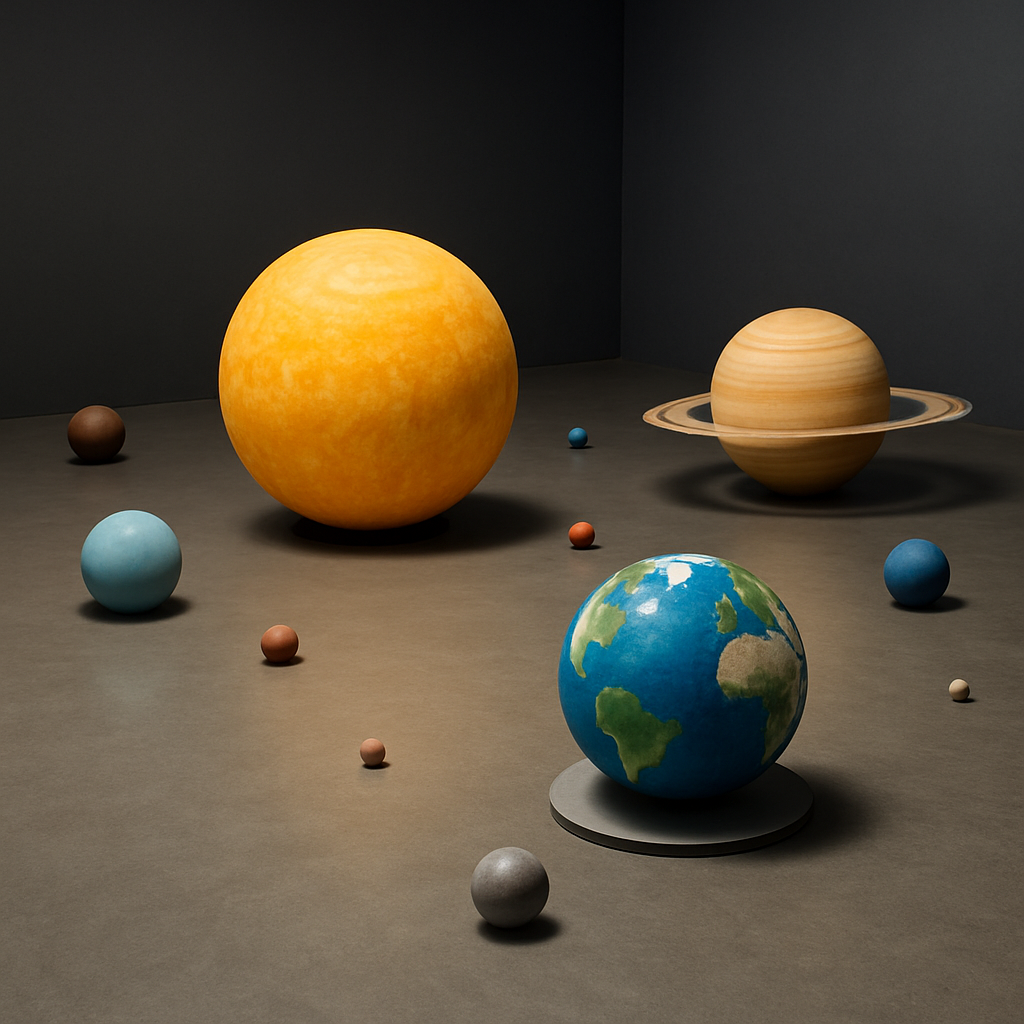WhoDonomics · 2025.08.04
손끝으로 우주를 만든다면, 그건 조형 예술가의 손일 것이다.
천문학자가 수치를 말할 때, 예술가는 그 크기를 직접 보여준다.
과학이 숫자로 말할 때, 예술은 그 숫자를 조형으로 해석한다.
🌍 행성의 ‘실제’ 크기를 감각으로
태양은 지구보다 109배 크다.
토성은 지구보다 95배 무겁다.
하지만 우리는 이 차이를 실감하지 못한다.
지구의 모형이 탁구공이라면, 태양은 운동장 크기여야 한다.
예술가는 이 간극을 조형으로 번역한다.
한 대학 전시에서는 태양을 농구공 크기로 만들고, 지구는 쌀알로 표현했다.
목성은 고구마, 수성은 깨알 크기로 구성되었다.
이 조형물은 단순한 오브제가 아니라, 정보의 번역기다.
🛰 NASA와 함께한 조형예술
NASA는 과학자뿐 아니라 예술가와도 협업한다.
예를 들어, TED 무대에서 공개된 천체 모형 프로젝트는
실제 행성 간 거리를 도보로 측정한 설치 작품이다.
참여자들은 실제 거리(천문단위)를 자신의 걸음 수로 체험한다.
지구~화성까지 78걸음, 목성까지 400걸음, 해왕성까지는 1000걸음 이상.
단순한 산술이 아니라, 몸으로 느끼는 우주다.
과학이 추상적일 때, 예술은 구체적인 경험을 만들어낸다.
🪐 왜곡된 스케일, 감각으로 회복하다
천문학은 스케일의 학문이다.
하지만 너무 작거나 너무 커서 실감이 어렵다.
여기서 미니어처 아티스트의 힘이 드러난다.
그들은 천문단위를 센티미터로 줄이고, 구조를 유지한다.
이때 중요한 건 “무엇을 기준으로 줄이느냐”다.
예술가는 시각적 균형을, 천문학자는 물리적 정밀도를 본다.
둘의 협업은 스케일과 감각의 타협점을 찾는 과정이다.
🌌 천문단위를 ‘공간’으로 번역하기
1AU(약 1억5천만 km)는 태양~지구 거리다.
이 수치를 전시장 바닥에 표시한 설치물은,
관객에게 거리의 체감을 제공한다.
1억km라는 숫자보다,
‘30걸음’이라는 경험이 더 오래 남는다.
이러한 공간적 번역은
아이부터 성인까지 모두를 위한 우주 언어 교육이 된다.
📐 과학을 환원하는 예술의 언어
예술가는 단지 꾸미는 사람이 아니다.
과학 데이터를 감각적 언어로 번역하는 통역자다.
그들은 숫자를 만지고, 공식을 걷고, 단위를 관객에게 체험시킨다.
그 손끝에는 보이지 않는 우주가 조각되어 있다.
🧪 음소분석 코너
miniature [ˈmɪn.i.tʃɚ]
/ˈmɪn/: 짧은 ‘민’, 강세
/i/: 빠르게
/tʃɚ/: /tʃ/ 파찰음 + /ɚ/ 중성
→ 발음 팁: ‘미니처’가 아닌 ‘미-니-쳐’로 부드럽게 연결

Sculpting the Cosmos — Where Art Meets Astronomy
What if you could hold the entire solar system in your hands?
For sculptors and installation artists, that’s not just a fantasy — it’s a creative mission.
While astronomers describe planets using numbers and ratios,
artists make those same concepts visible, touchable, and emotionally real.
🌍 Experiencing Real Planetary Scale
The Sun is 109 times wider than Earth and over 300,000 times heavier.
Yet most people cannot truly grasp the size difference.
In one university exhibit, the Sun was portrayed as a basketball,
while Earth was reduced to a grain of rice placed several meters away.
Jupiter became a potato; Mercury, a poppy seed.
These small but powerful models allow people to understand space through comparison,
bridging the gap between data and physical intuition.
They turn abstract math into emotional insight.
🛰 NASA + Artists: Beyond Science
NASA has long partnered with artists to make science accessible.
One TED-stage project re-created planetary distances using walking paths.
Visitors walked from planet to planet, counting their steps.
30 steps to Mars, 400 to Jupiter, over 1000 to reach Neptune.
By using their own bodies as measuring tools,
participants gained a real sense of the vast emptiness between worlds.
Such experiences shift astronomy from a science class to a sensory journey.
🪐 Fixing Scale with Miniatures
Astronomy deals with numbers too big or small to imagine.
Miniature artists take astronomical units (AU) and shrink them into meters or centimeters,
allowing models to fit into parks, galleries, or even tabletops.
Artists focus on harmony and balance.
Scientists demand accuracy and scale.
Their collaboration creates new ways of understanding —
ways that feel as truthful as they are beautiful.
🌌 Translating Distance Into Space
1 AU (about 150 million kilometers) is the distance from Earth to the Sun.
In one exhibition, this was shown as 30 steps on a floor.
Instead of trying to imagine a huge number,
visitors felt the distance by simply walking.
This kind of spatial translation makes the language of space easier to understand —
not just for scientists, but for everyone, including children.
It transforms dry numbers into something poetic and profound
#천체모형 #조형예술 #우주축척 #천문학전시 #NASA예술협업 #스케일감각 #천문단위 #우주체험 #미니어처아트 #예술과과학